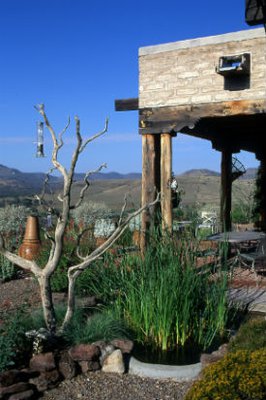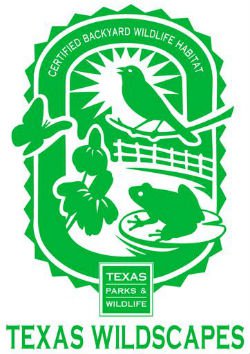Wildscapes: Texas Wildscapes Certification
What are the essentials?
An effective wildlife habitat will provide all three basic needs for wildlife- food, shelter, and water in a way that they can readily use and easily access. Providing the basics, in a diverse and well planned manner, will make your garden more attractive to native wildlife.
Since wildlife thrives in the presence of plants they have adapted to, native plants are encouraged in the Wildscapes program. Properties applying for certification must ensure that at least 50% of the plants used in their landscaping are native to Texas.

How can I provide the basics?
The most important step in developing a Wildscape is learning about the plants and soils that characterize your region. The fact that a plant grows in an area without human assistance does not make that plant “native” to that area. Introduced plants are not good substitutes for the native plants used by wildlife. Texas has 10 distinct ecoregions. A careful look at undisturbed areas around your home will help you understand what plants should be found in your ecoregion.
Plants provide both food and shelter requirements for wildlife. Select plants for their food value as well as plants that will grow to different heights and density. This layering effect will allow wildlife to select areas they find most comfortable.
Be Firewise
While shrubs and brush are important to wildlife, and we do want to have some brush on our properties, it is also important that we maintain this with a sense of community responsibility and safety. We all have a role to play in protecting our home and community from fire.
This is especially important if you livein an area known as the Wildland Urban Interface (WUI), a place where homes backup against large stretches of undeveloped land. This area becomes particularly vulnerable in drought situations, when extensive areas of dry brush become a tinder box. Providing a separation–ideally 30 feet–between your home and these fuels is very important. This area does not need to be lost to wildlife habitat, though - use it to plant materials that maintain their moisture, use hardscape to create shelter, and use it for your supplemental feeding and watering features.
Avoid plants that are highly resinous or dry quickly close to your home. Cedar/juniper, yaupon, possum haw, rosemary and grasses should not be used around the foundation of your home. Replace them with plants that maintain their moisture without becoming resinous. Succulents are ideal. For more information on being firewise in these areas, visit Texas A&M Forest Service's Wildland Urban Interface: Communities in Action.
Traps to avoid
A Wildscape is not an excuse for ignoring or violating city and county regulations. Health and safety regulations make it possible for people to live in harmony with each other. Wildscapes make it possible to live in harmony with wildlife and each other. Maintain your Wildscape for your enjoyment and that of your neighbors.
A Wildscape is a safe harbor in which wildlife can find the resources they need. It is not an “official wildlife sanctuary.” You determine what can and cannot be done on your property within the context of your city or neighborhood association guidelines.
What will I need for certification?
We are not accepting new applications for Wildscape Certification at this time, but we encourage you to certify your landscape through the National Wildlife Federation’s Certified Wildlife Habitat program.
Previous certifications required:
- At least 50% native plants.
- Food for the wildlife year round. A feeder alone will not be considered, but if at any time there is not food available for the wildlife from plants, a feeder would then be required.
- Shelter for the wildlife. This might include various plant features, should include plants in each of the tall trees, understory, shrubs, bushes and wildflowers; may include nest boxes, brush piles, rock piles, toad houses and other shelter projects.
- Water in a useable, reliable form for the wildlife.
- Wildscapes certification fee is $15.00.
